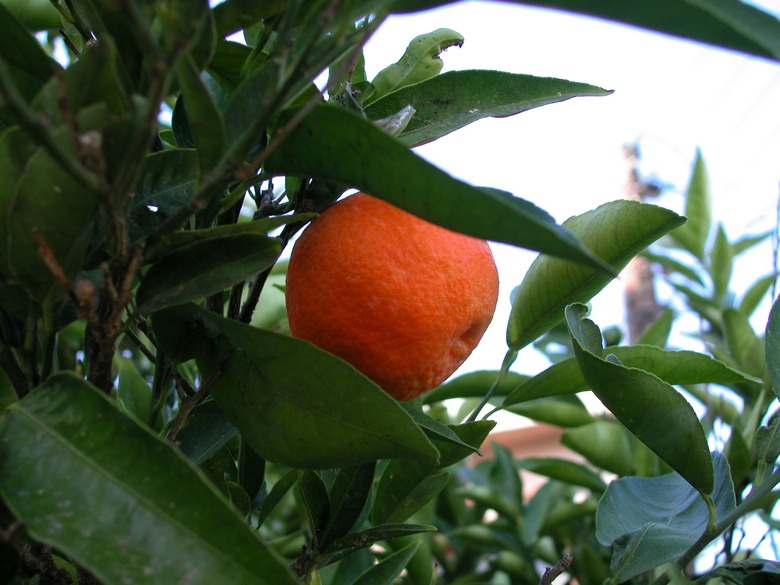Citrus Fruit With Black Spots
A sweet, crisp orange (Citrus sinensis) picked fresh from the tree or a tart grapefruit (Citrus x paradisi) for breakfast can make your day, but it's not always a simple, easy process to grow citrus. Black spots are a symptom of many of the common problems that affect citrus, including bacterial infections, fungal diseases and pest infestations. Citrus trees generally grow in U.S. Department of Agriculture plant hardiness zones 8 through 10.
Fungal Diseases
Step 1
Septoria spot causes spotting on various citrus fruits. The early symptoms of this fungal disease appear as tiny tan to reddish pits on the fruit, usually around 1/16 inch in diameter which grow to around 1 inch and become nearly black and sunken into the white, spongy part of the rind. The disease worsens with heavier rainfall and moist conditions. Alternaria rot, another fungal disease, causes black spots on citrus, particularly oranges and lemons (Citrus x limon). On navel oranges in particular, the spots are firm and dark brown to black and extend to the core of the fruit. The disease often makes its presence known after harvest and during storage. Citrus black spot is a serious threat to citrus crops from around the world, but hasn't been found outside of Florida, as of 2013. Several forms of lesion can materialize on citrus fruit, almost all of which can be black spots appearing on the fruit.
- A sweet, crisp orange (Citrus sinensis) picked fresh from the tree or a tart grapefruit (Citrus x paradisi) for breakfast can make your day, but it's not always a simple, easy process to grow citrus.
- Several forms of lesion can materialize on citrus fruit, almost all of which can be black spots appearing on the fruit.
Bacterial Diseases
Step 1
Citrus blast, also called black pit and bacterial blast on citrus is caused by the bacterium Pseudomonas syringae. Symptoms begin on the leaves and leaf petioles of the citrus and result in small black spots all over the flesh of the fruit. The bacterium spreads through sometimes inconspicuous injuries caused by insects or abrasions and is helped along by windy, cool conditions. Planting a windbreak can help protect your citrus trees from the damaging effects of this bacteria.
Pests
Step 1
The citrus rust mite, also known as silver mite, generally feeds on the outside of young fruit that is 1/2 inch or more in diameter. As the mites feed, the rind cells are destroyed and the surface of the fruit may become silvery, rusty-brown or black, depending on the species of citrus you're growing. Citrus mites, like many other mites, can quickly grow to hard-to-manage numbers, so monitor your citrus trees carefully, especially if you've had problems in the past. While sooty mold is a fungal disease, it's caused by insects. Aphids, thrips, scale insects, whiteflies and psyllids all produce honeydew, which hosts the sooty mold fungus. The fungi can quickly cover fruit, leaves and other parts of citrus trees, causing black, sooty spots that sometimes cover the entire outside of fruits. The fruit is still edible if you wash it off with mild soap and warm water.
- Citrus blast, also called black pit and bacterial blast on citrus is caused by the bacterium Pseudomonas syringae.
- As the mites feed, the rind cells are destroyed and the surface of the fruit may become silvery, rusty-brown or black, depending on the species of citrus you're growing.
Prevention
Step 1
Healthy citrus trees are much less susceptible to the fungi, bacteria and pests that cause black spots than stressed or otherwise unhealthy fruit. Prune trees to thin them out and allow air circulation, which can help prevent or reduce fungal diseases. Avoid over-fertilizing your trees and water deeply to the roots throughout the season. Monitor your citrus trees for pests — citrus rust mite populations often begin growing in spring, reaching a peak in midsummer.
References
- University of California Statewide Integrated Pest Management Program: Septoria Spot
- University of California Cooperative Extension Agriculture and Natural Resources Ventura County: Septoria
- University of California Statewide Integrated Pest Management Program: Alternaria Rot
- University of California Statewide Integrated Pest Management Program: Bacterial Blast (Citrus Blast)
- Oregon State University Agricultural Experiment Station: Diseases of Deciduous Fruit trees Incited by Pseudomonas Syringae van Hall
- University of Florida IFAS Extension: Citrus Extension Black Spot
- Purdue University National Agricultural Pest Information System: Survey Status of Citrus Black Spot
- University of California Statewide Integrated Pest Management Program: Sooty Mold
- The Old Farmer's Almanac: Lemons and Oranges
